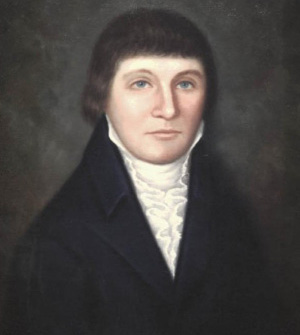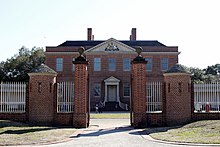
Joseph Hewes was an American Founding Father and a signer of the Continental Association and U.S. Declaration of Independence. Hewes was a native of Princeton, New Jersey, where he was born in 1730. His parents were members of the Society of Friends, commonly known as Quakers. Early biographies of Hewes falsely claim that his parents came from Connecticut. Hewes may have attended the College of New Jersey, known today as Princeton University but there is no record of his attendance. He did, in all probability, attend the grammar school set up by the Stonybrook Quaker Meeting near Princeton.

The North Carolina General Assembly is the bicameral legislature of the state government of North Carolina. The legislature consists of two chambers: the Senate and the House of Representatives. The General Assembly meets in the North Carolina State Legislative Building in Raleigh.

Richard Caswell was an American politician and lawyer who served as the first and fifth governor of the U.S. state of North Carolina from 1776 to 1780 and from 1785 to 1787. He also served as a senior officer of militia in the Southern theater of the American Revolutionary War. As a delegate to the First Continental Congress, he was a signatory of the 1774 Continental Association.
The North Carolina General Assembly of 1778 met in three sessions in three locations in the years 1778 and 1779. The first session was held in New Bern from April 14 to May 2, 1778; the second session in Hillsborough, from August 8 to August 19, 1778; the third and final session in Halifax, from January 19 to February 13, 1779.
The North Carolina General Assembly of 1779 met in three sessions in three locations in the years 1779 and 1780. The first session was held in Smithfield from May 3 to May 15, 1779; the second session in Halifax, from October 18 to November 10, 1779; the third and final session in New Bern, from January to February, 1780.
The Delaware Constitution of 1776 was the first governing document for Delaware state government and was in effect from its adoption in September 1776 until its replacement by the 1792 constitution.
The Hillsborough District Brigade of militia was an administrative division of the North Carolina militia established on May 4, 1776. Brigadier General Thomas Person was the first commander. Companies from the eight regiments of the brigade were engaged in 55 known battles and skirmishes in North Carolina, South Carolina, and Georgia during the American Revolutionary War. It was active until the end of the war.
The North Carolina Provincial Congresses were extra-legal unicameral legislative bodies formed in 1774 through 1776 by the people of the Province of North Carolina, independent of the British colonial government. There were five congresses. They met in the towns of New Bern, Hillsborough (3rd), and Halifax. The 4th conference approved the Halifax Resolves, the first resolution of one of Thirteen Colonies to call for independence from Great Britain. Five months later it would empower the state's delegates to the Second Continental Congress to concur to the United States Declaration of Independence. The 5th conference approved the Constitution of North Carolina and elected Richard Caswell as governor of the State of North Carolina. After the 5th conference, the new North Carolina General Assembly met in April 1777.

The 1st New York State Legislature, consisting of the New York State Senate and the New York State Assembly, met from September 9, 1777, to June 30, 1778, during the first year of George Clinton's governorship, first at Kingston and later at Poughkeepsie.

The government of North Carolina is divided into three branches: executive, legislative, and judicial. These consist of the Council of State, the bicameral legislature, and the state court system. The Constitution of North Carolina delineates the structure and function of the state government.
North Carolina state troops in the American Revolution were the initial military units created in a transition from the Province of North Carolina under British rule to independence from British rule. Most units did not last long as such and were either transferred to the Continental Army or state militia instead.
The North Carolina General Assembly of 1780-1781 was the fourth elected legislative body of the State of North Carolina. The assembly consisted of a Senate and House of Commons that met in three sessions in at least two locations in the years 1780 and 1781. Each of the existing 50 North Carolina counties were authorized to elect one Senator and two members of the House of Commons. In addition, six districts also elected one House member each. The first two sessions were probably held in New Bern, North Carolina in April and September 1780. The third session met in Halifax from January 27, 1781 – February 13, 1781.
The North Carolina General Assembly of 1836–1837 met in the Government House in Raleigh from November 21, 1836 to January 23, 1837. The assembly consisted of the 120 members of the North Carolina House of Commons and 50 senators of North Carolina Senate elected by the voters in August 1836. During the 1836 session, the legislature created Davie County, but it was not until 1842 that Davie County began sending delegates to the General Assembly. William H. Haywood, Jr was elected speaker of the House of Commons and Charles Manley was elected clerk. Hugh Waddell was elected President of the Senate and Thomas G. Stone was elected Clerk. Richard Dobbs Spaight, Jr. was the Governor in 1835 and 1836. He was elected by the previous legislature. In 1837, the Governor of North Carolina, Edward Bishop Dudley from New Hanover County, was elected, for the first time, by the people vice the legislature. The Whigs would control North Carolina politics until 1850. While in power, their notable achievements included funding railroads and roads, public education, and State chartered banks.
The North Carolina General Assembly of 1781 met in Wake Court House from June 23 to July 14, 1781. Each of the 50 North Carolina counties were allowed one Senator and two members of the House of Commons; 6 districts/boroughs towns also elected one House member each.
The justice of the peace was a court official that existed at the county or district level in from the colonial period of the Province of North Carolina until 1968 in the U.S. State of North Carolina. Originally, the Justices of the Peace had authority over the Magistrates Courts, which covered petty criminal offenses and some civil matters. They were appointed by the Governor of the Province. In 1741, they were given the authority to solemnize marriages in counties that did not have ministers or with the consent of the local minister. After North Carolina became a State, they continued authority over Magistrates Courts at the county level, as well as solemnizing of marriages. They were commissioned by Governor of North Carolina upon recommendation of the North Carolina General Assembly. After the U.S. Civil War, they were authorized to register slave marriages that took place before the war. The number of Justices of the Peace in North Carolina continued to grow until the 1950s. The lack of uniform jurisdictions, rules and appointment procedures across North Carolina counties led to major changes in the North Carolina judicial system in 1968 that abolished the Justices of the Peace and placed some of their responsibilities with Magistrates.
The North Carolina General Assembly of 1783 was the state legislature that convened in Hillsboro, North Carolina from April 18, 1783, to May 17, 1783. Members of the North Carolina Senate and the North Carolina House of Commons were elected by eligible North Carolina voters. This was the last assembly to meet during the American Revolution. Much of their time was devoted to taking care of the North Carolina soldiers that fought in the war.

The Fifth North Carolina Provincial Congress was the last of five extra-legal unicameral bodies that met beginning in the summer of 1774. They were modeled after the colonial lower house. These congresses created a government structure, issued bills of credit to pay for the movement, organized an army for defense, wrote a constitution and bill of rights that established the state of North Carolina, and elected their first acting governor in the fifth congress that met in 1776. These congresses paved the way for the first meeting of the North Carolina General Assembly on April 7, 1777 in New Bern, North Carolina. The Fifth Congress met in Halifax from November 12 to December 23, 1776. Richard Caswell served as president, with Cornelius Harnett as vice-president.
The North Carolina General Assembly of April to June 1784 met in New Bern from April 19 to June 3, 1784. The assembly consisted of the 120 members of the North Carolina House of Commons and 50 senators of North Carolina Senate elected by the voters in April 1784. As prescribed by the 1776 Constitution of North Carolina, the General Assembly elected Alexander Martin to continue as Governor of North Carolina. In addition, the assembly elected members of the Council of State.
The North Carolina General Assembly of October 1784 met in New Bern from October 25, 1784 to November 26, 1784. The assembly consisted of the 116 members of the North Carolina House of Commons and 55 senators of North Carolina Senate elected by the voters on August 20, 1784. As prescribed by the 1776 Constitution of North Carolina the General Assembly elected Richard Caswell as Governor of North Carolina and members of the Council of State.
The North Carolina General Assembly of 1785 met in New Bern from November 18, 1785, to December 29, 1785. The assembly consisted of the 114 members of the North Carolina House of Commons and 54 senators of North Carolina Senate elected by the voters on August 19, 1785. During the 1785 session, the legislature created Rockingham County. As prescribed by the 1776 Constitution of North Carolina the General Assembly elected Richard Caswell to continue as Governor of North Carolina and members of the Council of State.















